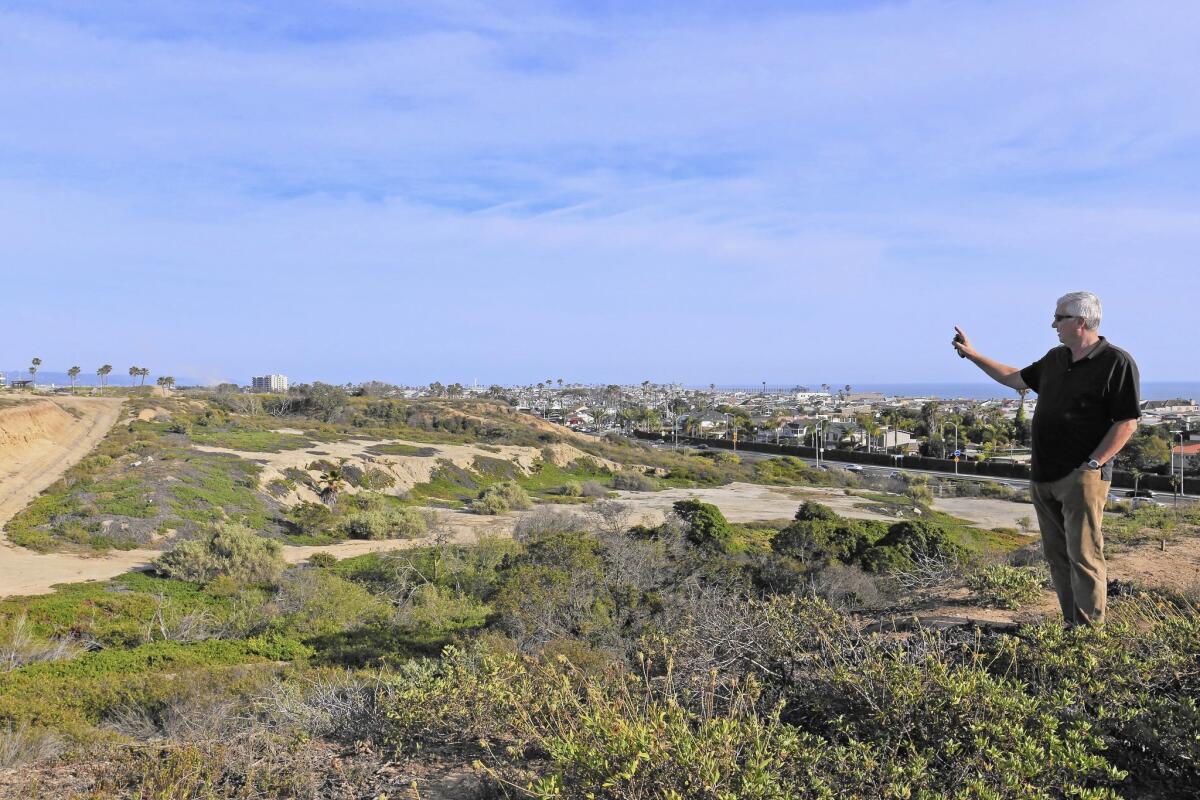The animals along California’s coast, survivors of droughts and oil fields, have a new foe

- Share via
Against all odds, the animals of the 401-acre Newport Banning Ranch oil fields have endured.
Burrowing owls, ospreys, least terns, red foxes, San Diego fairy shrimp and California gnatcatchers have survived decades of drought, oil production and encroaching development.
But now they’re in the crosshairs of a uniquely dangerous predator: the Coastal Toady.
Yes, I’m talking about the construction-friendly, science-doubting members of the California Coastal Commission — at least some of them.
The showdown had been scheduled for this Thursday, when the agency holds its monthly meeting at Newport Beach City Hall. Now the Banning Ranch issue has been postponed.
But the matter isn’t going away, so let me tell you what’s at stake.
We’re talking about a plot of land 1,000 feet from the Pacific Ocean near Costa Mesa, Huntington Beach and Newport Beach, where oil has flowed since the 1940s. Some of the pumps are rusty and idle now, but the Big Oil owners — Shell and ExxonMobil are behind one of the companies involved — and their investment partners have a new plan to make money bubble up from the ground. Namely, a mega-development called Newport Banning Ranch that originally called for 1,375 beach pads along with a resort hotel and retail colony.
The developers are promising — either generously or with extraordinary chutzpah, depending on your perspective — to clean up the environmental damage they inflicted.
Newport Banning Ranch has been running full-page newspaper ads depicting its property as a rusted-out brownfield. They say they’ll open a nature preserve for public use — as long as that public gets behind a huge development in which the developers walk away with millions.
But much of the property was designated as Environmentally Sensitive Habitat Area by the Coastal Commission staffers whose expertise is supposed to inform the decisions of the politically appointed commissioners, and courts have ruled against development in such areas.
A staff ecologist called this one of the few “reasonably intact wetland-bluff ecosystems” left on the California coast. The staff recommended against the habitat-crushing project last year and said only about 19 acres were suitable for development.
But some commissioners weren’t swayed by science.
So they toured the property and reached their own conclusions, which they shared at an October hearing that came off as another embarrassment, like many of the commission’s recent meetings.
Commissioner Martha McClure called the property a “400-acre mess” that looked more like Oklahoma than California.
Commissioner Wendy Mitchell said of the vernal pools that are critical to the habitat, “When I was a kid, we called them … ditches.”
Commissioner Janelle Beland, the queen bee of the commission and a member of Gov. Jerry Brown’s administration, questioned the work of a state Fish and Wildlife biologist who backed the Coastal Commission staffer.
The commission then rejected the recommended denial of the project and ordered the staff, led at the time by Executive Director Charles Lester, to work with the developer and devise an acceptable plan.
In other words, the commission had already made up its mind. It wanted a development, native creatures, traffic concerns and science be damned.
The staff was demoralized, and the situation soon got worse.
In February, commissioners fired Lester in a 7-5 vote despite his work being praised by staff and hundreds of coastal advocates, government officials and former coastal commissioners.
The commissioners who dumped Lester pooh-poohed suggestions that they were developers’ best friends. They insisted that Lester, who has an Ivy League geochemistry degree and knew more about the Coastal Act than anyone alive, just wasn’t up to the job.
And then late in April, the staff reversed itself on Banning Ranch.
With Lester out of the way and an interim replacement in his seat, the pressure was on. Staff recommended approval of a revised Banning Ranch proposal of roughly 895 homes, 45,000 square feet of retail and a 75-room hotel.
The approval recommends that multiple conditions be met. Still, the building area would be nearly triple the size the staff originally found acceptable, which came as a big disappointment to development foes who’d rather pool public and private money to buy and safeguard the environment. They told me even the scaled-back version would be a win for developers and a devastating blow to threatened animals and their habitat.
And now comes word, in a story by my colleague Bettina Boxall, that Coastal Commission Chairman Steve Kinsey toured the property again on Dec. 22 with developers, whom he apparently found rather persuasive.
I’ve seen agency records, by the way, indicating that Kinsey has had at least seven contacts with the developers since 2014.
But he didn’t report one last December, and that’s a no-no. If a commissioner meets with an interested party, the public and opponents have a right to know what they talked about.
Kinsey did eventually report the December meeting last week, four months after the fact, and just after being asked about it by The Times.
And there’s more:
Boxall reported that Kinsey sent an email to a staffer in January saying he believed many of the areas given environmentally sensitive designations by the staff “seem unwarranted.”
He defended himself in an email to The Times.
“I reject any suggestion that my comments were intended to pressure staff,” he said.
Of course he does.
But it’s not in the public’s best interest for commissioners to pretend they’re scientists, or to advocate for developers, or to try to rewrite the Coastal Act.
This is just the latest piece of evidence that this commission has lost its way.
I’ve seen hallway confabs out of public view during meetings, which may or may not be legal.
One testy commissioner F-bombed people who attended a hearing.
Complaints have been filed against two commissioners for accepting donations from the domestic partner of a powerful lobbyist and then voting on projects the lobbyist brought before the commission.
Another commissioner voted on a project involving a client in her consulting business.
We have no idea how many private meetings with interested parties go unreported. And even when such contact is reported through what’s called the ex parte system, access is much easier to come by for wealthy project applicants. Routinely, they hire high-powered, politically connected agents who just happen to be chummy with commissioners.
In the case of Banning Ranch, records show that of more than 40 ex parte communications between commissioners and interested parties, more than two-thirds were with representatives of the developers.
State officials do not have to remain silent while this nonsense plays out.
Assembly Speaker Anthony Rendon and Senate President Pro Tem Kevin de León can’t fire the eight commissioners appointed by their predecessors, but they can remind them there’s a thing called the Coastal Act and a thing called ethics.
Brown has been in deep hibernation on this issue, to his discredit. Unlike the legislative leaders, he has the authority to fire all four of his commissioners if he wants to.
Something to consider.
Public trust, like natural habitat, is rapidly disappearing.
Twitter: @LATstevelopez
ALSO
A lost gem? New Mojave Trails monument rules appear to bar rock hunting
Don’t blame the smelt: The salmon too reflects the dire state of the California Delta
The wells have run dry in this California town, so why is a $1.2-million water system untapped?
More to Read
Sign up for Essential California
The most important California stories and recommendations in your inbox every morning.
You may occasionally receive promotional content from the Los Angeles Times.











